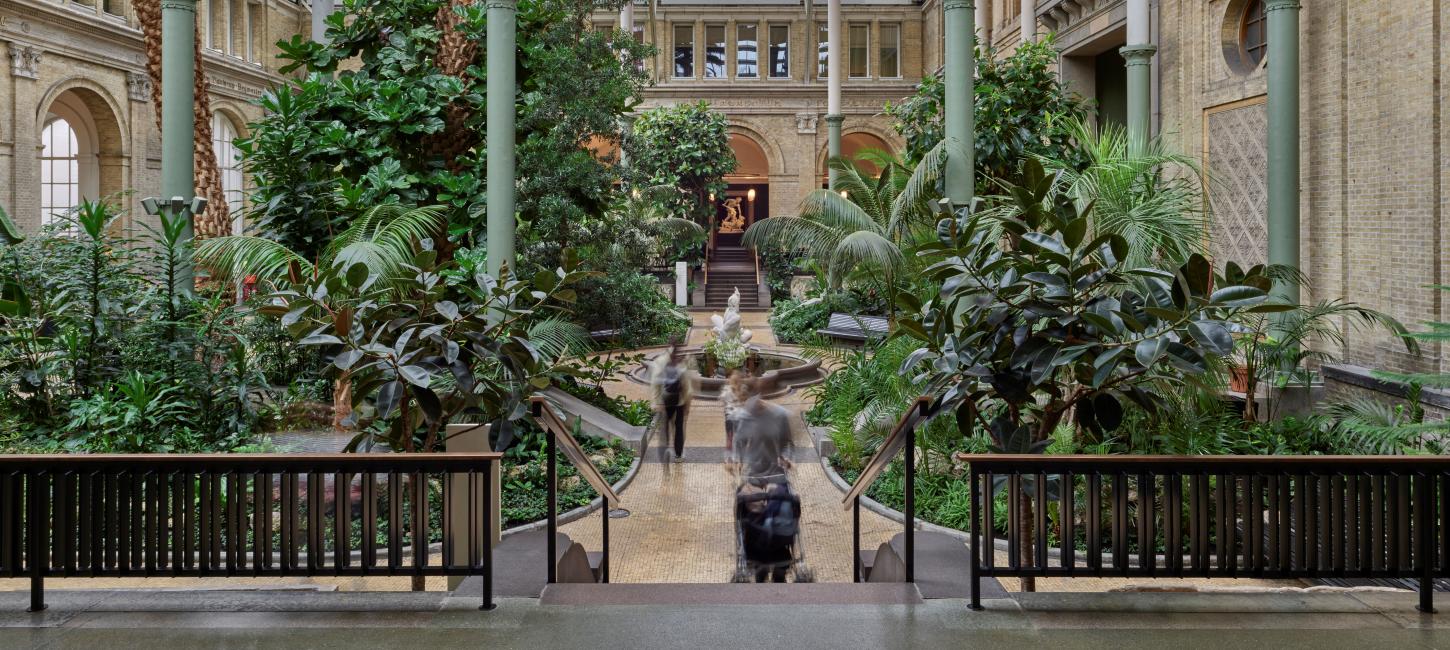The Carlsberg City District in Copenhagen
A strong cultural heritage comes to life in the recently renovated neighborhood, The Carlsberg City District, a place embedded in the history, culture...

Carlsberg’s influence on Copenhagen is impressive and far-reaching. Every building stone laid is rooted in the deep beliefs of both brewers.
Experience the cultural heritage that the Carlsberg brewers have left behind throughout Copenhagen.
The New Carlsberg Glyptotek is a museum comprising over 10.000 art pieces, including sculptures, paintings, and mummies and covers 6000 years of art. The New Carlsberg Glyptotek is a self-employed institution funded by the New Carlsberg Foundation as the only museum. The museum is also a research institution committed to generating new knowledge about the art collection. The museum opened to the public in 1897 after brewer Carl Jacobsen wanted to gift his art collection to the public. Carl believed that art is for everyone and contributes to enriching people’s lives. It wasn’t a coincidence that Carl Jacobsen’s art collection consisted of sculptures, as he believed in three-dimensional art because this was the closest thing to people’s primary conditions. Carl Jacobsen emphasized the importance of the museum housing an oasis, as this would make the visit even more enjoyable for the public, which is why the Winter Garden was built. The museum’s location was also chosen with the public in mind due to its next-door neighbour Tivoli, which was and still is one of the most popular attractions in Copenhagen.
In 1879 Carl Jacobsen created the scholarship, Albertina, as he was a great admirer of the famous Danish sculptor Berthel Thorvaldsen and named the scholarship after Bertel’s Italian name Alberto. The grant sums were used to build sculptures and statues around Copenhagen, including the castings of the bronze copies of antique statues in Ørstedsparken. Furthermore, J.C. Jacobsen was also one of the most significant contributors to the monument of the physicist H.C. Ørsted also situated at the park.
The spire of Nikolaj church is another example of Carl Jacobsen’s passion for the art and beauty in Copenhagen. After a fire in 1795, the church had been without a spire until the beginning of the 20th century, when Carl Jacobsen decided to finance a new spire for the church, which was completed in 1909. The building became an art exhibition hall in 1981 and followed in the spirit of Carl Jacobsen. Today Nikolaj Kunsthal showcases various Danish and International contemporary art.
Being a man of the society, J.C. Jacobsen joined Copenhagen’s civic representation from 1843-1858. Here he pushed to make Copenhagen’s water supply up to date, which finally broke through when cholera harassed the city. This event kickstarted the construction of Copenhagen’s waterworks, also called Pumpehuset, which became Denmark’s first waterworks. It was J.C. Jacobsen himself, who laid the foundation stone of the works in 1857 and came to play a big part in providing Copenhagen with clean water. In 1986 the building turned into a concert venue, which continues to be a popular meeting point today.
Cisternerne was connected to the Copenhagen waterworks when it was completed in 1859. The Cisterns worked as the waterworks’ height container and helped store a lot of the water. It was then the Copenhagen waterworks which helped pump up the clean water from the Cisterns to the homes and buildings in Copenhagen. After the water reservoir stopped being in use in 1933, the place turned into a museum, which continuously showcases art exhibitions based on the unique architecture and climate of the space.
In 1890 the Art Industry Museum (today Designmuseum Denmark) was built on the town hall square of Copenhagen on the initiative and funding of Carl Jacobsen. Carl also donated different objects, the museum’s headquarters and the four quarters of net profit from his newly launched Carlsberg pilsner, emphasizing his passion for great design and art. The museum moved to its current location in Bredgade in 1926 and changed its name to Designmuseum Denmark in 2011. The original building of the Art Industry Museum subsequently served different functions but was acquired in 1978 by Tivoli, who named it the Tivoli Castle. The New Carlsberg Foundation has continuously supplied the Designmuseum Denmark with donations.
When the Botanical Garden got its location right by Nørreport in 1870, J.C. Jacobsen was busy being a part of building the iconic greenhouses in collaboration with the architect P.C. Bønnecke. J.C. Jacobsen moreover influenced other corners of the park, like the urinals, which J.C. Jacobsen thought should be in enamelled slate plates instead of the typical marble. Meanwhile, his son Carl Jacobsen helped create the many bronze castings of antique statues in the garden, contributing to the mythical theme that runs through the garden.
As a result of Carl Jacobsen’s vast collection of sculptures and plaster casts of famous antique statues, Carl got the opportunity to decorate the ground floor of the National Gallery of Denmark with his many castings when the museum opened in 1896, which became the Royal Cast collection. And besides influencing the museum’s exhibitions, Carl Jacobsen also became the first director of the Royal cast collection at the National Gallery of Denmark from 1896 until 1914. In 1995 the Royal Cast collection moved to West India Warehouse, where the collection is still displayed today.
The elephants from the famous Elephant Gate aren’t the only elephants to have inhabited the Carlsberg City District. In the past, before arriving at their final destination at the Copenhagen Zoo, the elephants briefly stayed in transit at the stables of the Carlsberg City District. As the Copenhagen Zoo is located only a stone’s throw away from the Carlsberg City District, the elephants were transported to Copenhagen through the local station of Carlsberg, called Station Hof, which today is the S-train station Carlsberg.
The Jesus Church in Valby and the Carlsberg family are inextricably linked, right from the funding of the church to the crypt below the church that houses the family burial ground. Until the construction of the Jesus Church, there hadn’t been a church in the district of Valby, and with the expansion of the Carlsberg brewery and additional workers, a need for a church had arisen—and Carl Jacobsen, who, besides having a passion for art, also had a love for Christianity. Carl had received a paid-out inheritance from J.C. Jacobsen instead of letting him inherit his brewery due to tensions between the two. And it was a part of this heritage that Carl used to construct the church. Inspired by old Southern European churches and a requirement of how the church should resound with beautiful music and surpass all the other churches in Copenhagen in terms of beauty, Carl Jacobsen got architect Vilhelm Dahlerup to build the church in 1891. The detached church tower next to the church is called the Alf-tower, named after the brewer’s oldest child, who died as a child.

Senior Manager – Press & PR